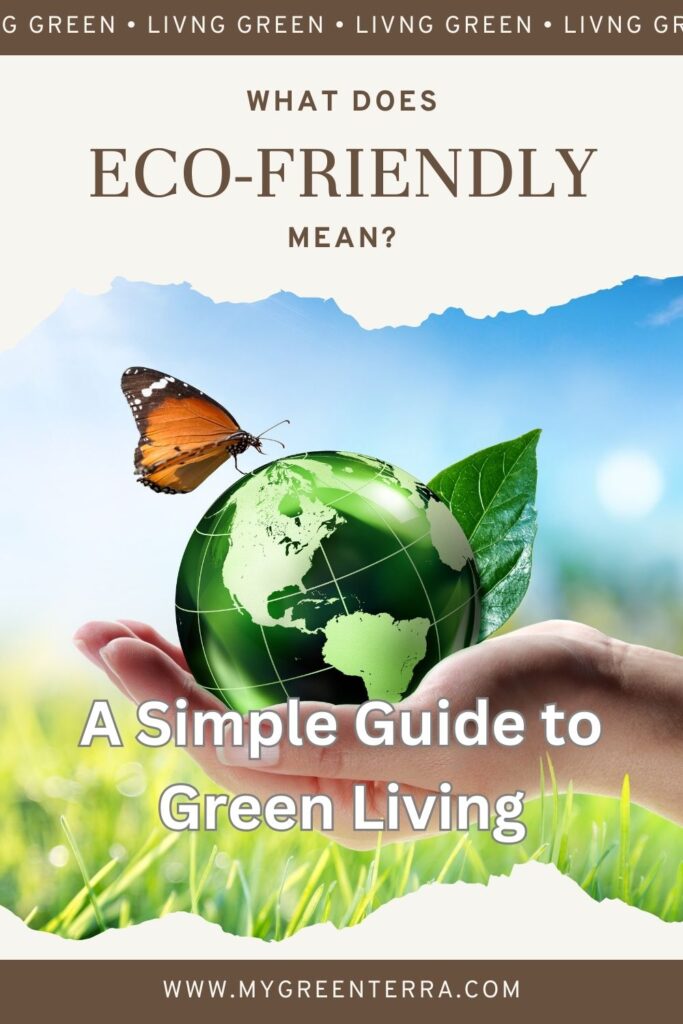What Does Eco-Friendly Mean?
I get commissions for purchases made through links in this post. View our Affiliate Disclaimer.
In an era where climate change and environmental sustainability are at the forefront of global discussions, the term “eco-friendly” has become a buzzword. But what does it truly mean to be eco-friendly? Is it just about recycling and using less plastic, or does it encompass a broader range of practices and behaviors?
Understanding the concept of ecofriendliness is crucial as it directly impacts our planet and future generations. It’s not just a trend or a marketing strategy; it’s a lifestyle choice that seeks to reduce our environmental footprint and promote a healthier, more sustainable world.
We will discuss the meaning of ecofriendliness, explore its importance, debunk common misconceptions, and provide practical tips on how to incorporate ecofriendly practices into our daily lives. By the end of this journey, we hope to provide a clear and comprehensive understanding of what it means to be truly eco-friendly. So, let’s embark on this green journey together!
The Definition Of Eco-Friendly

The term “eco-friendly” is derived from the words “ecological” and “friendly,” indicating a harmonious relationship with the environment. In essence, something is considered eco-friendly if it is not harmful to the environment. This term is often used interchangeably with other phrases such as “environmentally friendly,” “green,” or “sustainable.”
However, ecofriendliness extends beyond just not causing harm. It also implies a proactive approach to conserving resources like water and energy, reducing emissions and waste, and promoting biodiversity.
It’s about making conscious choices that favor the environment, whether it’s in the products we buy, the way we travel, or how we manage waste.
Ecofriendly can refer to a wide range of things, including products, services, laws, guidelines, and lifestyle choices. For instance, an eco-friendly product could be made from recycled materials, use less energy, be biodegradable, or not involve harmful chemicals in its production process.
It’s important to note that the term “eco-friendly” is not regulated, meaning that companies can use it loosely for marketing purposes. Therefore, it’s crucial for consumers to do their research and understand what makes a product or service truly eco-friendly.
A distinction must also be drawn between eco-friendly vs. green living. Although these concepts are similar and have the same goal, there is a difference in the concepts.
Green living is a lifestyle, while eco-friendliness is more related to products and practices in the home and business that have a direct impact on the environment.
The Importance Of Being Ecofriendly

Being ecofriendly is more than just a personal choice; it’s a collective responsibility that has far-reaching implications for our planet and future generations.
The following are why this topic is so important on a global scale.
- Protecting the Environment. Ecofriendly practices help to conserve natural resources, reduce waste and pollution, and maintain biodiversity. By choosing eco-friendly products and services, we can help to reduce the demand for environmentally harmful alternatives and promote sustainable industries.
- Combating Climate Change. Many eco-friendly practices, such as reducing energy consumption and minimizing greenhouse gas emissions, directly contribute to the fight against climate change. By adopting a more eco-friendly lifestyle, we can help to slow the global warming rate and mitigate its impacts.
- Promoting Health and Well-Being. Ecofriendly practices often align with healthier lifestyles. For example, organic food is not only better for the environment, but it’s also free from harmful pesticides and chemicals. Similarly, walking or cycling instead of driving can reduce air pollution and improve physical health.
- Economic Sustainability. In the long run, eco-friendly practices can lead to economic benefits. Energy-efficient appliances, for instance, may have higher upfront costs, but they save money over time through reduced energy bills. Similarly, companies that adopt sustainable practices often find that they can reduce costs, improve their brand image, and attract new customers.
- Ethical Responsibility. Many people feel a moral obligation to leave a healthy planet for future generations. Being eco-friendly is one way to fulfill this ethical duty.
In essence, being ecofriendly is about making choices that are good for the environment, good for our health, good for the economy, and good for future generations. It’s a holistic approach that recognizes the interconnectedness of all aspects of life on Earth.
Misconceptions About Being Ecofriendly
While the concept of being eco-friendly is gaining popularity, there are still several misconceptions that can hinder its full understanding and adoption. Let’s debunk some of these myths:
1. Being Eco-Friendly Is Expensive
Many people believe that eco-friendly products are always more expensive than their conventional counterparts.
While some eco-friendly products may have higher upfront costs, they often prove to be cost-effective in the long run due to their durability and efficiency.
Moreover, being eco-friendly also involves practices that are completely free, such as reducing water usage, composting, or choosing to walk or bike instead of driving.
2. Ecofriendly Products Don’t Perform As Well
There’s a common misconception that eco-friendly products, especially in the realm of cleaning supplies or personal care products, are less effective.
However, many eco-friendly products perform just as well, if not better, than traditional products. They also have the added advantage of being free from harmful chemicals.
3. Being Eco-Friendly Is Inconvenient
Some people perceive eco-friendly practices as being time-consuming or inconvenient. However, many eco-friendly habits, such as recycling or turning off lights when not in use, are easy to incorporate into daily routines.
Furthermore, technology and innovation are continually making it easier to be eco-friendly without sacrificing convenience.
4. One Person Can’t Make A Difference
It’s easy to feel that individual efforts won’t make a significant impact on global environmental issues. However, if each person makes small changes to their lifestyle, the collective impact can be enormous. Every ecofriendly choice contributes to a larger, global effort.
5. All Eco-Friendly Claims Are True
Unfortunately, “greenwashing” which is defined as the unethical strategy of making inaccurate, misleading, or unsubstantiated claims about the environmental benefits of a product, service, or company, is a common marketing tactic.
It’s essential to scrutinize eco-friendly claims and look for certifications or evidence to back them up. Understanding these misconceptions is the first step toward making more informed and eco-friendly choices. In the next section, we’ll explore practical examples of eco-friendly practices you can incorporate into your daily life.
Examples Of Eco-Friendly Practices

Adopting an eco-friendly lifestyle involves making conscious choices that reduce harm to the environment.
Here are some examples of eco-friendly practices that can be incorporated into various aspects of our daily lives.
1. Sustainable Consumption
- Opt for products with minimal packaging or packaging made from recycled materials.
- Choose products that are made from sustainable, natural, or recycled materials.
- Buy locally produced goods to reduce the carbon footprint associated with transportation.
- Opt for energy-efficient appliances and devices.
2. Waste Reduction
- Practice the 3 R’s: Reduce, Reuse, and Recycle.
- Compost organic waste to reduce the quantity of waste going to landfills and create nutrient-rich soil for gardening.
- Use reusable shopping bags, water bottles, and coffee cups instead of single-use plastics.
3. Energy Conservation
- Turn off lights and unplug electronics when not in use.
- Use energy-efficient light bulbs and appliances.
- Consider implementing renewable energy alternatives, such as solar or wind power, for your home.
4. Water Conservation
- Fix leaks promptly and use water-saving appliances and fixtures.
- Collect rainwater for watering plants.
- Limit the use of water in gardening and choose plants that require less water.
5. Sustainable Transportation
- Walk, bike, or use public transportation instead of driving when possible.
- Consider carpooling or use fuel-efficient vehicles.
- Plan and combine trips to reduce the number of times you need to drive.
6. Eco-Friendly Diet
- Choose organic, locally grown produce.
- Reduce meat consumption as livestock farming has a significant environmental impact.
- Minimize food waste by planning meals and using leftovers creatively.
Remember, every small action counts. Incorporating these eco-friendly practices into your lifestyle will contribute to a healthier, more sustainable planet.
How To Become More Ecofriendly
Becoming more eco-friendly is a journey that involves making conscious decisions that favor the environment. Here are some practical tips to help you become more eco-friendly:
- Educate Yourself. Knowledge is the first step toward change. Learn about environmental issues and understand how your lifestyle choices impact the environment. Stay informed about the latest eco-friendly products and practices.
- Start Small. Don’t feel pressured to make all the changes at once. Start with small, manageable steps like turning off lights when you leave a room, reducing water usage, or recycling. Gradually incorporate more eco-friendly habits into your routine.
- Make Mindful Purchases. Before making a purchase, consider its environmental impact. Opt for products that are durable, made from sustainable materials, and come with minimal packaging. Support companies that prioritize sustainability.
- Reduce, Reuse, Recycle. Minimize waste by following the 3 R’s. Reduce your consumption, reuse items as much as possible, and recycle whenever you can.
- Conserve Energy and Water. Be mindful of your energy and water usage. Use energy-efficient appliances, turn off electronics when not in use, and try to conserve water.
- Choose Sustainable Transportation. Whenever possible choose a sustainable transportation method such as walking, biking, or using public transportation. If you need to drive, consider carpooling or using a fuel-efficient vehicle.
- Advocate for the Environment. Use your voice to advocate for environmental policies and practices. Support businesses that are eco-friendly and encourage others to do the same.
Remember, being eco-friendly is not about perfection but progress. Every small step you take towards being more eco-friendly makes a difference. In the next section, we’ll explore the future of ecofriendliness.
The Future of Eco-Friendliness
As we look towards the future, it’s clear that eco-friendliness will continue to play a crucial role in shaping our world. Here’s what we can expect:
- Increased Awareness and Education: As the impacts of climate change become more apparent, awareness about the importance of ecofriendliness is likely to increase. We can expect more emphasis on environmental education in schools and communities to empower individuals to make eco-friendly choices.
- Technological Innovations: Technology will continue to provide innovative solutions to environmental challenges. From renewable energy technologies to biodegradable materials and energy-efficient appliances, technological advancements will make it easier for us to adopt eco-friendly practices.
- Sustainable Business Practices: More businesses are recognizing the value of sustainability, not just for the environment but also for their bottom line. We can expect to see an increase in companies adopting sustainable practices, offering eco-friendly products, and being transparent about their environmental impact.
- Government Policies: Governments around the world are starting to take action on environmental issues. We can expect to see more policies and regulations that promote eco-friendly practices and penalize environmental harm.
- Community-Led Initiatives: Communities are coming together to take action on environmental issues. From community gardens to local recycling programs and conservation initiatives, these grassroots efforts are likely to continue and grow.
The future of eco-friendliness looks promising. However, it requires each one of us to play our part. By adopting ecofriendly practices and advocating for the environment, we can help to create a sustainable future for all.
Conclusion
Understanding what it means to be eco-friendly and incorporating eco-friendly practices into our lives is not just a trend—it’s a necessity. As we’ve explored in this blog post, being eco-friendly means making conscious choices that reduce our environmental impact, from the products we buy to the way we use resources.
While there are misconceptions about being eco-friendly, the reality is that every small action counts. Whether it’s turning off the lights when leaving a room, choosing products with less packaging, or advocating for environmental policies, each step we take towards being more eco-friendly contributes to a larger global effort.
The future of ecofriendliness is promising, with increased awareness, technological innovations, sustainable business practices, government policies, and community-led initiatives. However, the success of these efforts depends on each of us. By educating ourselves, making mindful choices, and advocating for the environment, we can help to create a healthier, more sustainable world.
In the end, being eco-friendly is about recognizing our responsibility to protect the environment and future generations. It’s about making choices today that will create a better tomorrow. So, let’s continue on this green journey together for the sake of our planet and for the generations to come.
Get more posts like this
Subscribe to our mailing list and get interesting homesteading and green living info and updates to your email inbox.
Thank you for subscribing.
Something went wrong.







